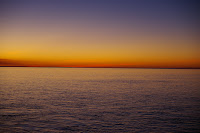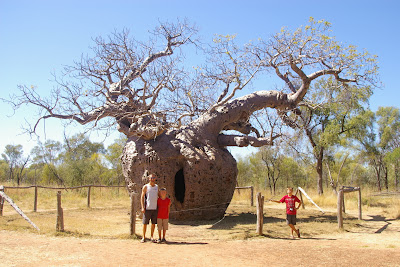DERBY 1ST JUNE – 15TH JUNE
Derby is the entrance to the Kimberley’s and with that comes the Boab Tree, only found in this region of Australia. We never get tired of seeing these amazing specimens and you will probably get bored of seeing the photos of them but too bad. I will give you a bit of a history lesson on the Boab Tree.
 |
| This is a classic Boab Tree. This one was outside the visitors centre at Derby. The brown mark on it is stains from the bore water sprinklers. |
The botanical name is Adansonia Gregorii and they are related to the Madagascan and African Adansonia species known as Boababs. It is thought that seeds from Africa have floated across the ocean landed and grown here. They can withstand flood and fire therefore they can grow very old, over a thousand years. They are hollow trees with their inner lining being fibrous which is what soaks up all the water and expands giving it the wide birth and enabling it to store enough water to get through a dry season. They are deciduous, bare in the dry season and are known to grow their leaves before the first rains of the wet season. They have flowers and fruit/ seed pods. The seed pods are commonly known as boab nuts because they are hard shell, mostly oval in appearance and can vary in size. The nuts have a velvety feel and when broken open white pith is found covering the seeds. The locals eat this white pith, no we haven’t tried it yet! Another name for the Boab tree is a bottle tree and you can see why. So now you know all about Boabs.
 |
| Here is a selection of different shaped boab nuts with a tennis ball to give you an idea of the size of them |
 |
| The inside of a boab nut, that is the white pith some people eat. |
Derby is a dead end town and by this I mean the same road that takes you in also takes you out. Others would think I actually meant it is a “dead “town and I can sort of see why they would think that for it doesn’t look like much BUT, now that we have stayed in Derby for two weeks while Pete worked and the fact I am writing this after 2 months of living on the station and Derby is the closest thing to a “town” that we get, I do not think that at all. It has most things that are needed to get by just don’t have the need to buy many clothes and you will be alright; Broome is only 220km’s away and they have a good range!
There is only two C.P's in Derby and only one likes kids! So we stayed at The Kimberley Entrance Caravan Park which was quite a nice park and especially when it came to using one of their shower blocks which was newly refurbished. It was very well done, modern, bright and great shower heads; lovely! There was a resident white peacock called Percy ( of course) and there was also these lovely Tawny Frog Mouth owls.
 |
| "Home Sweet Home" |
 |
| "You can't see me!" |
 |
| "What are you looking at!" |
 |
| The trees in the back ground are the caravan park we were staying at. The jetty is about 500meters behind me( I am taking the photo) . |
One of the really interesting things about Derby is the huge mud flats that surround it. Going out to the jetty you get a good view of how vast they are. The mud flats around town get wet when Derby is having one of its 11 meter tides, which are the highest tides in Australia.
The water in King Sound (which is the name of the bay) is brown as far as you can see out to sea because of the shallow waters and the mud flats. People say you need to go the jetty at high tide then back at low tide and that will give you a real sense of the volume of water that gets moved around, we kind of did as you can see below. The jetty is a "D" shape with driving only allowed one way on it.
When we were sitting on the jetty at sunset eating our fish (barramundi) and chips, (yummy) we were amazed at how fast and strong the water was as it was going out, it was swirling around the pylons of the jetty.
 |
| Our yummy Barra and chips! |
 |
| Sunset over King Sound Bay |
Today’s jetty was built in 1964, replacing the old wooden one from 1894. It used to be a T shape and was used to export pearl shell and wool. Back in the 1800's there used to be a horse drawn tramway crossing the mud flats via a cause way which is now the road to the jetty. In the 60’s live cattle was exported with fuel, oil and provisions being the main imports. This would have been a huge effort for it only would have been possible to load onto barges when the tide was right. This would be the same for getting out of the bay they would have to wait for a high tide. Cattle are no longer loaded from this jetty it all goes to Broome or Darwin. I think the jetty is now only used for local supplies in and out.
The main attractions around Derby are the Boab Prison Tree, Frosty’s Pool and the Mayall’s Bore and Cattle trough, they are all within 500 meters of each other and just before you reach Derby.
The Prison Boab Tree
 |
| The Prison Boab Tree. You can see the hole left which used to be the door. |
The Boab Prison Tree is said to be over 1500 years old with a 14 meter circumference. The information at the tree tells a good story about what went on between the Aboriginals and the first settlers so I will relay some of it. Before Derby was established in 1883 Aboriginal people were kidnapped from the West Kimberley by settlers who were connected to the pearling industry, they were looking for divers and workers on the pearling boats. These kidnappers where named "blackbirders". They rounded people up, put them in chains and marched them to the coast and it is believed they may have held the prisoners captive at the Boab Tree while they were waiting for boats. When the early pastoralists came along they helped the blackbirders because they thought that by removing the young men it would guarantee peaceful behaviour from the older ones left behind, how wrong they were, the Aboriginals resisted. In 1887 a gaol was built only 5 km from the prison boab tree, then later in 1906 a new one was built in the then established town of Derby. Over the following decades hundreds of Aboriginals were held in the jails charged mostly with killing and eating livestock. Prisoners were made to walk anywhere from 24km to 84km a day and they came from all over the Kimberley and as far away as Fitzroy Crossing with the prison tree being a staging point along the way.
A small insight as to some of the things that went on.
A small insight as to some of the things that went on.
 |
| The sun on the back of the tree making it look almost purple in colour. |
 |
| This is the board I got all the information off, it shows the prisoners chained around their necks and I think it is the Prison Tree behind them. |
Alfred Mayall Bore and Cattle Trough
Alfred Mayall sunk a well here in the early 1890’s then in the 1910/11’s a bore was sunk to 322 meters deep. Around 1917 the cattle trough measuring 120 meters long was built and could feed 500 bullocks at a time all from the natural flow from the bore. I am not sure when but eventually the flow from the bore slowed and now a windmill pumps the water into the trough.
Frosty's Pool
Frosty’s Pool was built during the Second World War in 1944 by the troops in the 3rd General Transport Co. who were stationed in the area. They would bath in it and get some relief from the hot weather although being bore water it wouldn’t have been that cold but just nice to have a rinse off I suppose. They nicknamed it after one of the platoon members Charles L.V. Frost.
Peter was working for Spinifex Cabinets owned and operated by Scott and his wife Felicity, they also have a young son; a very nice family. Scot only employed one other young man Nathan and he just wanted a helping hand to get a few fit outs done on some new houses; so Pete helped put in kitchens and bathroom cupboards. He enjoyed his time and the company of different people to talk to, he even picked up a few tips on cabinet making. He rode his bike the 4km to work and back everyday leaving at 6am and getting back just before dusk cause he had no lights on his bike. Scott said he had at least 3 weeks of work for Pete but judging by how busy he was I think he would have had more if we needed to stay. While Pete was working for Scott we finally heard from the Kimberley Station job which was for the maintenance/ gardener job till December. The station is towards Fitzroy Crossing and about 100km out of Derby and the manager was coming into Derby so he wanted to meet Pete and have a bit of an interview, which he did. All went well so they asked for us all to come down and see the station, the house they were offering and to check out the Aboriginal community and the school. Scott very kindly gave Pete a Friday off so we could go down and check it all out. We were all happy with what was on offer and the boys were quite excited and apprehensive about the school so we said yes to the job and so our next adventure begins……..





No comments:
Post a Comment